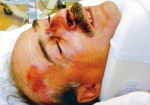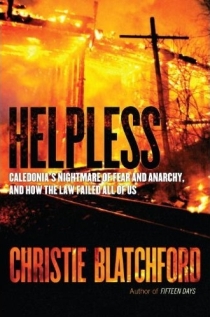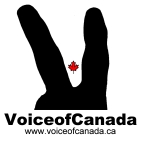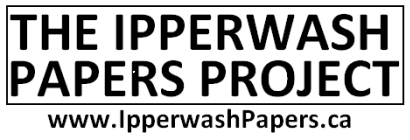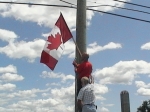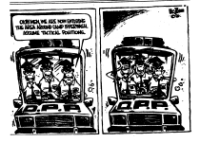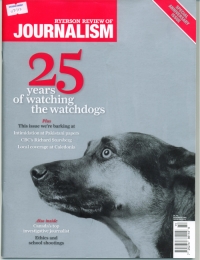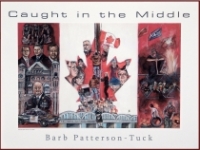 Some native militants have claimed the Mohawk Warrior flag is merely a benign ‘Unity Flag’ of peace with no sinister intent or symbolism behind its use, despite a long and highly visible association with extreme violence, intimidation and criminal activity in places like Oka, Akwasasne and Caledonia.
Some native militants have claimed the Mohawk Warrior flag is merely a benign ‘Unity Flag’ of peace with no sinister intent or symbolism behind its use, despite a long and highly visible association with extreme violence, intimidation and criminal activity in places like Oka, Akwasasne and Caledonia.
- VoiceofCanada feature: Caledonia Players – The Mohawk Warriors
Not only is this claim highly dubious on its surface, the birth of the Mohawk Warrior flag flag in violence and criminality has been well documented in a Masters thesis by a Concordia University student named Kahente Horn-Miller who “…is Bear Clan Kanienkehaka and lives near Montreal Canada on the Kahnawake Mohawk Territory…”
Horn-Miller’s mother Kahn-Tineta Horn – as she notes in the Acknowledgements section (page iv) – was a “Warrior during the Oka crisis”:
- Concordia University, Kahente Horn-Miller Master of Arts thesis, August 2003: The Emergence of the Mohawk Warrior Flag [PDF, 238p; accessed May 31/11, if no longer available – contact Mark Vandermaas for copy: info@caledoniavictimsproject.ca]
- Concordia University, May 12/09: Bio – Kahente Horn-Miller [PDF]
‘The Emergence of the Mohawk Warrior Flag: a symbol of Indigenous unification and impetus to assertion of identiy and rights commencing in the Kanienkehaka community of Kahnawake’ [PDF, 238p]
[p86-88 (PDF p94-96)]
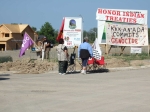 Early on in the research process it became apparent that there was more than one flag. In fact there are two flags. One is known as the Unity flag which stems from its creation in the context of the assertion of sovereignty in the early seventies with the establishement of the Independent North American State of Ganienkeh. The second flag is known as the Kahnawake Warrior Flag or Mohawk Flag which emerged at another time of assertion of sovereignty in the late 1980’s. […]
Early on in the research process it became apparent that there was more than one flag. In fact there are two flags. One is known as the Unity flag which stems from its creation in the context of the assertion of sovereignty in the early seventies with the establishement of the Independent North American State of Ganienkeh. The second flag is known as the Kahnawake Warrior Flag or Mohawk Flag which emerged at another time of assertion of sovereignty in the late 1980’s. […]
In May 1974, a group of Kanienkehaka seized a 612-acre former summer camp for girls at Moss Lake in upstate New York and claimed it as sovereign Kanienkehaka territory. They named this new terroritory Ganienkeh. […] After some shooting incidents where two-non-native citizens and a nine year old girl were injured, New York State…negotiated with the Kanienkehaka for their removal from the original site [of Ganienkeh].
In 1988, the Kahnawake Rotiskenrakete Warrior Society requested that Karoniaktajeh [creator of Unity Flag] make a flag specifically for them. The community of Kahnawake was organizing a bridge blockade in response to a series of raids on the community’s thriving cigarette industry. […]
The Kahnawake Mohawk Warrior Flag is now the one most easily identified and available for sale in flag, patch, pin and sticker formats. […]
The original [Unity] flag depicts a Warrior in profile that has long hair falling to the shoulders. […] Long hair is common amongst Indigenous peoples, what makes the cultures different is how they style it. This [similarity] is meant to promote a sense of common identity, therefore enabling all to use the flag…no matter what nation they are from.
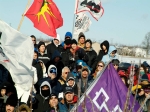 With reference to the Kahnawake Mohawk Warrior flag, in times of war, the men of the Haudenosaunee would shave their heads, leaving a round patch at the back of the skull, referred to as a scalp lock. Its purpose was to taunt the enemy into attempting to scalp the warrior or to make it easier for rapid travel through the trees. […]
With reference to the Kahnawake Mohawk Warrior flag, in times of war, the men of the Haudenosaunee would shave their heads, leaving a round patch at the back of the skull, referred to as a scalp lock. Its purpose was to taunt the enemy into attempting to scalp the warrior or to make it easier for rapid travel through the trees. […]
In times of peace the hair was allowed to grow. The Flag introduced at Ganienkeh has hair that is long. It has been suggested that perhaps this was another way for the Flag’s symbols to indicate and promote peace. [JT 07/23/02] The Kahnawake Warrior’s Flag has a more stylized version of the scalp lock, perhaps indicating the need for resistance, because it was designed in a time of tension and conflict as discussed above.
[p112 (p120 PDF)]
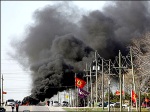 The Flag first came to international prominence in the summer of 1990, during the Oka standoff at Kanehsatake. […] Since that time, the Flag has shown up all over the world and continues to represent for many, unity and resistance. These concepts form the basis for various events such as Ganienkeh, the Oka Crisis, Ipperwash, Gustafsen Lake, and the Lobster Dispute at Esgenoopetitj (Burnt Church). […]
The Flag first came to international prominence in the summer of 1990, during the Oka standoff at Kanehsatake. […] Since that time, the Flag has shown up all over the world and continues to represent for many, unity and resistance. These concepts form the basis for various events such as Ganienkeh, the Oka Crisis, Ipperwash, Gustafsen Lake, and the Lobster Dispute at Esgenoopetitj (Burnt Church). […]
[p131-136 (p139-144 PDF]
Normal and Deviant Symbols
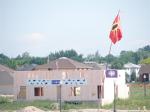 The Flag may be seen as a deviant symbol because it is used by Indigenous people to illustrate a unique culture in opposition to the dominant one which has been forced upon us. […] As a Kanienkehaka man states,
The Flag may be seen as a deviant symbol because it is used by Indigenous people to illustrate a unique culture in opposition to the dominant one which has been forced upon us. […] As a Kanienkehaka man states,
All that means is the men of the society or the men of the community….It has no meaning of warrior or nothing. Non natives put a tag on us. And we used that tag…against them. As soon as the warrior society was mentioned it was like – watch out the Indians are coming, get underneath your blankets and lock your doors. That’s what it meant to them. It meant fear to them – warrior society. And they’re the ones who have given us that name and we accepted that name. And we use it psychologically on them. And it still works today…And it still works. We’re in 2002 and it will still work. Go put a road block up right now. Want to see people go nuts? You’ll have a million cameras on you. The warrior society, what’s going on. Start rumors in town that something is going to take place over here. People are going to go nuts. […]
In accordance with Bhaba concept of hybridity, the Flag represents a modern day ‘hybrid’ of centuries old psychological warfare tactics used by the Kanienkehaka to generate fear in a population. […]
As a Mi’kmaq woman states,
You know they hid behind their wives and kids.
K: Who?
 K. What do you think it did to them to see it? The white fishermen.
K. What do you think it did to them to see it? The white fishermen.
They didn’t expect it. They didn’t expect the support we were going to get. It scares them.
K. Why do you think it scares them?
Because we have support from other reserves and when they found out there was going to be, they probably knew that the Warriors were coming. […]
[The] Kanienkehaka [at Oka] refused to concede defeat, as illustrated,
Just before the warriors were loaded onto the military buses, the soldiers had ripped away their flags. […] Somehow one of them had managed to suggle a warrior flag onto the bus. In a final gesture of defiance, the flag was unfurled and the convoy headed for Farnham [military base] under the insignia of the Mohawk Warrior Society.
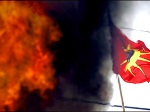 Some actions of individuals who use the Flag are perceived to be negative by the dominant society and as a result the Flag has also become a deviant symbol for some Indigenous people. It does not correspond to their usual frame of reference. Increased Indigenous involvement in gun battles over casinos, drug and gun running, and cigarette smuggling have resulted in instances where the Flag is juxtaposed against such incidences. […]
Some actions of individuals who use the Flag are perceived to be negative by the dominant society and as a result the Flag has also become a deviant symbol for some Indigenous people. It does not correspond to their usual frame of reference. Increased Indigenous involvement in gun battles over casinos, drug and gun running, and cigarette smuggling have resulted in instances where the Flag is juxtaposed against such incidences. […]
The cigarette trade brought increased wealth to the community of Akwasasne in the 1980’s. Casinos and other businesses were built to increase the economic self-sufficiency of the community. A struggle ensured over the inclusion of gambling in the community which resulted in a great deal of factionalism. […] Many of the people [of Akwasasne] who saw merit in the casinos professed themselves to be part of the Warrior Society. The casino issue brought violence to the community…and so some people are perceived to have misrepresented what the Flag stands for.
[CVP NOTE: The author includes this footnote on p135 (p143 PDF) re the casino violence:
“(133) At the height of the casino dispute at Akwasasne int he late 1980’s, the community was greatly fractionalized. The murder of two men has cast a shadow over Akwasasne. It must be resolved before they can move on.]
This is why there are comments like this one. He goes on to say,
To me it meant something, but after Akwasasne it kind of tarnished it. […] I find it hard, when you watch TV today, if there is violence, if there is something wrong. What’s the first thing they show on TV?
K: The flag?
Yeah. It’s got a symbol now of violence. [OJC 12/07/01]
This same conception was carried over to some of the Mi’kmaq…as illustrated by a Mi’kmaq woman,
First of all the Warriors kind of scared me. Because with the camoflage and everything, it was more like seeing a war. That’s still not native to me when you wear that kind of clothing. And a Warrior is more like – we are going to go out there and fight and nothing is going to stop us. Stuff like that eh. And I said – Oh my God. They are forgetting about the rest of the people here…It was scary for me and probably scary for a lot of people. Right away they didn’t want the Warriors. Even though there was a reason behind it. […] This shouldn’t be the way, fighting, getting killed or getting hurt. We tried to stop it any way we could. Some of us any way. And we almost became Warriors ourselves. [EW 02/08/02]
[p138 (p146 PDF)]
[…] as a Kanienkehaka man states,
We evolve as a people and unite under one flag. […] It took on the meaning of unity at Oka. Other nations throughout North America, they related the Indian interests to that flag. Whenever they see the flag they realize that there was a battle going on that need attention. I believe that it is to awaken our people to the fact that maybe your community is nice calm and peaceful at this time but in our community we are flying the flag to alert everyone and ask everyone for help, assistance to come to our aid. [LT 01/21/02]
[p149 (p157 PDF)]
[…] three main interpretations of the Flag have become prevalent among both the Kanienkehaka and Mi-kmaq populations that were the focus of this study. They are — awareness, unity and resistance. When situations emerge that require these three ideas to be evoked, the Flag is used in this regard as illustrated by its use during the Oka Crisis and by the Mi’kmaq, during the Lobster Dispute at Esgenoopetitj.
[CVP NOTE: A Quebec police officer – Corporal Marcel Lemay – was killed by Warriors at Oka. The author’s account is that the volley of shots fired in the direction of the police were defensive in nature, in response to police firing first. See p115 (p123 PDF).]
—————
COMMENTARY
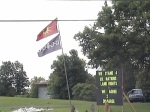 According to the research contained in the Horn-Miller paper the original ‘Unity Flag’ with its long-haired ‘peaceful’ Mohawk imagery was born out of the lawlessness and gun violence against non-natives and the U.S. government during the occupation of a girl’s camp in New York state. The artist actually lived in one of the occupied buildings at the time he created it.
According to the research contained in the Horn-Miller paper the original ‘Unity Flag’ with its long-haired ‘peaceful’ Mohawk imagery was born out of the lawlessness and gun violence against non-natives and the U.S. government during the occupation of a girl’s camp in New York state. The artist actually lived in one of the occupied buildings at the time he created it.
The more well-known shaved-head Mohawk Warrior ‘war’ version seen in Oka, Caledonia and more recently in Toronto’s High Park was specifically created at the request of organized criminals involved in cigarette smuggling at Kahnawake as a way to try to legitimize their greed and lawlessness under the banner of ‘aboriginal sovereignty.’
Warrior lawlessness in Akwasasne resulted in the deaths of two native people and, according to Dr. Whitney Lackenbauer in Carrying the Burden of Peace, the calling in of “sizable numbers of Ontario Provincial Police and RCMP officers, supported with CF [Canadian Forces] armoured vehicles” which could only temporarily restore order to the reserve: “In early 1990, a Canadian mechanized battalion moved to Cornwall in preparation for an aid to the civil power mission which was subsequently cancelled.”
- Journal of Military & Strategic Studies, Dr. Whitney Lackenbauer, 2008: Carrying the Burden of Peace: The Mohawks, the Canadian Forces and the Oka Crisis [PDF, 71p; VoC download PDF; see p13-14] (Dr. Lackenbauer is co-winner of the 2008 Donner Book Prize for Arctic Front – ‘best book on Canadian public policy’)
- Excerpts: VoiceofCanada feature: Caledonia Players – The Mohawk Warriors
The main theme of the Kahente-Horn paper – from start to finish – is that the Warrior flag is an assertion of sovereignty – especially during illegal occupations. It is used to signify that the land in question is no longer part of Canada, that Canadian laws do not apply to the occupiers, and that the occupiers are prepared to escalate their resistance to the point of violence if necessary.
As Horn-Miller notes from her interviews with native people the Mohawk Warrior flag is seen by them as a fear-invoking tool of psychological warfare against non-natives.
Indeed, the imagery of the Mohawk Warrior with his war-ready shaven head intentionally designed to taunt enemies (today, it is the Canadian government and non-natives generally) is indeed intended as a call to unity as some claim, but not to peace: the Warrior flag is a call to unite in war, of occupations, of violence, of intimidation, of vandalism, of inciting hatred and fear against those they deem to be repressing native culture.
This video, which glorifies Warrior lawlessness against non-natives and includes a ‘Hamas-esque’ image of masked child ‘warriors’ is shockingly candid in its native supremacist message:
- ‘Dedicated to the Mohawk Warriors’: [VIDEO, 3:09]
This and similar videos containing Mohawk Warrior imagery and anti-White hate can be found here:
- CaledoniaWakeUpCall.com feature: Native Supremacy Movement
The Mohawk Warrior flag in High Park, Toronto: a textbook case of lies, propaganda and intimidation
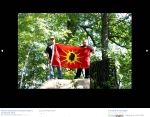 During the recent High Park, Toronto occupation over an alleged burial ground the Taiaiako’n Historical Preservation Society sent out an email in the name of its director ‘Rastia’ta’non:ha, dated May 26/11 – 2 days before our planned protest – in which it denied that any Mohawk Warriors were involved even though the Warrior flag has flown on the site since at least as early as Aug 28/10 as per the photo, right:
During the recent High Park, Toronto occupation over an alleged burial ground the Taiaiako’n Historical Preservation Society sent out an email in the name of its director ‘Rastia’ta’non:ha, dated May 26/11 – 2 days before our planned protest – in which it denied that any Mohawk Warriors were involved even though the Warrior flag has flown on the site since at least as early as Aug 28/10 as per the photo, right:
“We all know that the recent work in High Park has in no way involved Mohawk Warriors…“
- Taiaiako’n Historical Preservation Society email, May 26/11, 9:57pm [PDF]
One must ask the question, then: Why fly the Mohawk Warriors flag if there are no Warriors there? Indeed, why fly the flag of a violent criminal organization – whether it is in Caledonia or Toronto – if not to intimidate non-natives and government officials into complying with your demands?
- Taiaiako’n Historical Preservation Society: Gallery (several photos of Mohawk Warrior flags on site)
During our May 28/11 protest at High Park, prior to giving us a tour of the area where the Warrior and Six Nations flags had been flying, City of Toronto Director of Parks Richard Ubbens informed Gary McHale and me that he was unaware of the symbolism of the Warrior flag. He also informed us that it had been taken down in the week prior to our protest (after it was announced).
Ubbens also stated – categorically- that the City would never allow the site to become a no-go zone for non-natives, and that the City stood by its archeological report that had confirmed there was no native burial ground there.
As with the non-existent burial ground in High Park, the Haldimand Tract (which includes Caledonia, Hagersville, Cayuga, Brantford) victims suffered through extreme lawlessness over a non-existent land claim, as recorded in the rulings of three separate courts which heard injunction requests from land owners during the various illegal occupations which took place since 2006:
- ‘Caledonia: No More Nightmares’ event, Ottawa, March 22/11: Mark Vandermaas presentation, Part 2 – Caledonia Myths & Policy Issues: Vexatious Land Claims [VIDEO #2, 14:50] [PDF, 36p w/citations]
Based on the removal of the Warrior flag and Ubbens’ assertion that non-natives were not going to be excluded from any part of High Park, and that the City stood by its position there was no burial ground, it appeared that the City was – at least at that moment – in control of the site, and so we decided not to display or place our protest signs near the site as planned.
Gary McHale and I sincerely thanked Mr. Ubbens for speaking with us and giving us a tour of the site and, after being given access to the site and seeing the Warrior flags gone we promised not to return unless there is another occupation (which would be signified by the re-appearance of the flags).
Post-protest…
Toronto Police ‘Aboriginal Peacekeeping Unit’ video discovered
Subsequent to our May 28/11 protest we discovered a Toronto Police-produced video featuring the Mohawk Warrior flag in which a Parks department employee identified as Scott Laver appears along with spokespersons for the Taiaiako’n Historical Preservation Society and Cst. Tony Vella of the Toronto Police ‘Aboriginal Peacekeeping Unit’:
- Toronto Police Corporate Communications/Aboriginal Peacekeeping Unit, May 13/11 (uploaded May 14/11): High Park BMX to relocate… [VIDEO, 5:59] (video opens w/Warrior flag flying; also flies in background while Toronto Parks employee and police speak to camera.
Since the OPP and Ontario government claim that the role of police in Caledonia is ‘peacekeeping’ Toronto residents should be very concerned about the existence of an ‘Aboriginal Peacekeeping Unit’ in their police force:
- Caledonia: No More Nightmares presentation, Ottawa, March 22/11: Mark Vandermaas presentation: An Illegal Peacekeeping Mission on Canadian Soil [VIDEO, 9:39] [PDF, 36p incl. citations, begins p12]
One of the groups involved in the High Park occupation supports the use of violence and calls itself ‘Red Power United.’ Harrison Friesen, spokesperson for Red Power United can be seen in the Toronto Police video above beginning at 4:37 wearing black headband. In 2010 the RPU site posted a link (page has since been removed) to a native supremacist magazine called ‘Redwire’ that published a how-to instruction article for attacking non-native property and infrastructure. More info on RPU and Redwire can be found here:
- Caledonia Victims Project, May 23/11: JOINT NEWS RELEASE re High Park, Toronto protest
- VoiceofCanada, June 21/10: VoiceofCanada, June 21/10: RedWire Magazine’s blueprint for terror & sabotage by native ‘revolutionaries’ paid for by federal funds?
- Caledonia Victims Project, June 30/10: Feds gave native supremacist magazine $1.2M
Warrior flag on-site as early as August 2010
We discovered that the Warrior flag had been displayed on the High Park site long before the recent media reports — at least as early as Aug 28/10 (see photo above).
Threats against non-native activists
A number of threats have been made against us by someone calling themselves ‘sgreen.’ These were posted in comments on the site of blogger ‘Blog Wrath’ who covered our protest in depth. In ‘sgreen’s’ May 30/11, 5:49pm comment, after falsely claiming the Mohawk Warrior flag ‘doesn’t exist’ – that there were only ‘Unity’ flags present – he warns:
“So before you come back to High Park, get your facts straight and don’t publish anymore [sic] of your BS about our people. It is definately [sic] guarenteed [sic] next time you will be met with resistence [sic] by our men. McHale be informed and be warned.”
At 7:41pm, May 30/11 ‘sgreen’ replies to another commenter who had chided him for making “idle threats”:
“Not an idle threat…something that will actually happen if McHale and his morons decide to come to back [sic] to High Park and cause more trouble with his racist propaganda.”
False allegations against Gary McHale
1. At 11:07pm, May 31/11:07 am ‘sgreen’ states that “the RCMP went to McHale’s home on Thursday to investigate him…” The RCMP visit never happened – it was a complete fabrication.
2. In their email dated May 26/11 the Taiaiako’n Historical Preservation Society fabricated an allegation that Gary McHale was a member of a white supremacist group:
“Calling on all members of Red Power United, Friends of Snake Mound, and Six Nations/The Mohawk Nation. To stand united against the ideas and beliefs of Gary McHale the founder of CANACE and a racist member of White Pride World Wide, who is planning an action against the work being done at Snake Mound!”
- Taiaiako’n Historical Preservation Society email, May 26/11, 9:57pm [PDF]
A similar version of this false allegation was also posted in a new anti-Gary McHale page on the website of Red Power United (accessed June 01/11, 1:53pm).
“Gary McHale the founder of CANACE is a racist member of White Pride World Wide who has targeted the Mohawk people of Six Nations.”
This, of course, is not the first time that native protesters and those who support them have fabricated such allegations. In 2010 a Six Nations newspaper settled a lawsuit with us after they falsely accused four non-native activists, including Gary McHale and me, of being white supremacists seeking to exterminate native people.
The case was settled when the paper agreed to publish two op-eds by us along with a ‘clarification’ that it has no evidence we are members of white supremacist groups or that we support their ideology:
- Tekawennake News op-ed series, July 14-21/10, Gary McHale, Mark Vandermaas, Merlyn Kinrade, Doug Fleming: Healing Two Communities [PDF, 7p]
- see also: CANACE.ca feature: ‘We Believe…‘
Keeping the City of Toronto’s Parks Department in the dark?
It is inconceivable that the Toronto Police Aboriginal Peacekeeping Unit which produced – and appeared in – the Red Power United/Taiaiako’n/Warrior propaganda video did not know what the Warrior flag meant. If so, why did they not inform Parks Director Richard Ubbens? He clearly told us that he had no knowledge of the flag’s symbolism.
- Toronto Police Corporate Communications/Aboriginal Peacekeeping Unit, May 13/11: High Park BMX to relocate… [VIDEO, 5:59]
I cannot believe Ubbens would have allowed one of his employees to appear in the video had the police informed him of the sinister connotations of the Warrior flag and its violent legacy. If the Toronto Police Aboriginal Peacekeeping Unit didn’t know; or if they did know, but didn’t inform Ubbens, then that is even more troubling.
The High Park occupation, no matter how it is framed in terms of rehabilitating an area damaged by BMX bicycle riders (a worthy goal) to protect a (non-existent) burial site, was nothing more, and nothing less than a declaration of sovereignty on a micro-scale by people who know full well what the Warrior flag means.
It should be a source of concern that the Toronto Police and Parks Department are cooperating with pro-violence organizations such as Red Power United and the Mohawk Warriors, or anyone else who supports their legacy. They should also be concerned about the fabricated claims of white supremacist connections made against Gary McHale by the Taiaiako’n Historical Preservation Society. If this organization will lie to smear non-native activists, one must ask what else are they are lying about?
In any event, no one should be fooled by attempts to rewrite the ignoble history of the Mohawk Warrior flag and the threat to the rule of law it poses by those who fly it.
References
- VoiceofCanada feature: Caledonia Players – The Mohawk Warriors
- Caledonia Victims Project, May 23/11: Joint News Release re High Park, Toronto protest
- Blog Wrath, May 28/11: The Ghosts of Caledonia’s past haunt Toronto’s High Park
- Toronto Sun, May 17/11: Warmington: Where’s the next First Nations’ target?
- Michael Coren blog, May 17/11: BMX Aboriginals
- National Post, May16/11: Mohawks set up camp in Toronto’s High Park (incl. map showing location)
- Toronto Police Corporate Communications/Aboriginal Peacekeeping Unit, May 13/11: High Park BMX to relocate… [VIDEO, 5:59]
- CBC News, May 17/11: Archeologist disputes native High Park claims: 2009 study found no evidence of native burials on the site
- Torontoist, April 21/11: City, First Nations spokespeople say High Park “Burial Mound” claims are doubtful
- Red Power United: Direct Action (videos/photos, including role in G20 violence)
- Red Power United video: G20 New World Order
- National Post, June 17/10: Mayor says U.S. over-reacting with travel alert (Red Power United plans to block highways, threatens violence vs. police)
- ‘Caledonia: No More Nightmares’ presentation, Ottawa, March 22/11: Mark Vandermaas presentation: ‘Caledonia: a National Security Issue’ [PDF, 36p w/citations; begins p8], [VIDEO, 14:50; begins at 05:34] (also includes extensive info re Warrior support by radical unionists, anarchists and anti-Israel groups)
- ‘Caledonia: No More Nightmares’ presentation, Ottawa, March 22/11: Mark Vandermaas presentation: ‘An Illegal Peacekeeping Mission on Canadian Soil‘ [VIDEO, 9:39] [PDF, 36p incl. citations, begins p12]
Mark Vandermaas, Founder
Caledonia Victims Project
info@caledoniavictimsproject.ca

